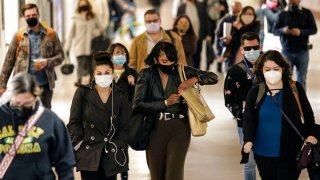
Even as the COVID-19 outlook for San Mateo County improves, health officials warn that the virus is not going to disappear.
During a meeting of the county's Board of Supervisors on Tuesday, Louise Rogers, chief of San Mateo County Health, explained her thinking behind COVID becoming endemic.
"I think the way we're really thinking about this is to deemphasize the word 'end' in 'endemic'," Rogers said. "It's not that the virus is going to disappear. Endemic is really about accepting that it will be present in the environment and we all have to take steps to protect ourselves and our family members and our communities in ways that are appropriate for the situation."
In San Mateo County and across the state, the COVID situation is improving as case rates fall.
“We see February's local COVID-19 situation beginning much better than January," Rogers said.
On Monday, the county saw a seven-day average of 85 cases per 100,000 people, a considerable drop from the early January peak of 239 cases per 100,000.
In addition, hospitalizations are falling. In recent days, county data shows that daily COVID
Local
And while the county plans to align with the state's decision to lift its indoor mask mandate for vaccinated residents, Rogers said businesses and organizations will be able to make their own decisions when it comes to masking.
"We can expect as we go around, certainly in the next months, that there will be a need to pull out a mask because the business that you're interacting with or the organization has that requirement, even if it is not the law," Rogers said.
Get a weekly recap of the latest San Francisco Bay Area housing news. Sign up for NBC Bay Area’s Housing Deconstructed newsletter.
And she encouraged people to assess their own individual risk when it comes to masking.
Dr. Anand Chabra, San Mateo County Health COVID-19 mass vaccination section chief, also reminded that getting vaccinated remains the most important way to protect against COVID-19, as vaccinated and boosted people are less likely to end up hospitalized from COVID compared to unvaccinated people.
Across the county, 82% of total residents have been fully vaccinated while almost 90% have received at least one vaccine dose and almost 400,000 booster doses have been administered.
“We want to see that all eligible residents receive a booster to maintain their optimal protection," Chabra said.
But certain groups -- including children ages 5-11 and Black, Latinx and Pacific Islander populations -- have vaccination rates less than 80%.
However, about 64,000 people who were vaccinated marked their race/ethnicity as 'other' or 'unknown.'
And given that about one in five people who tested positive in the county did not disclose their race, Rogers also warned against over-interpreting data, especially when it comes to race and ethnicity.



